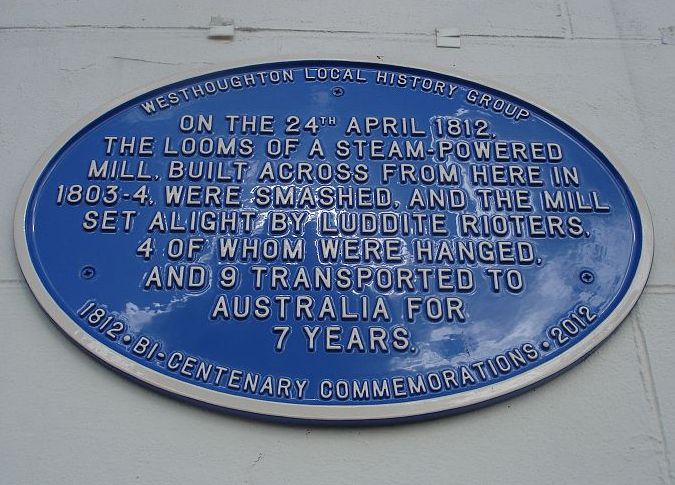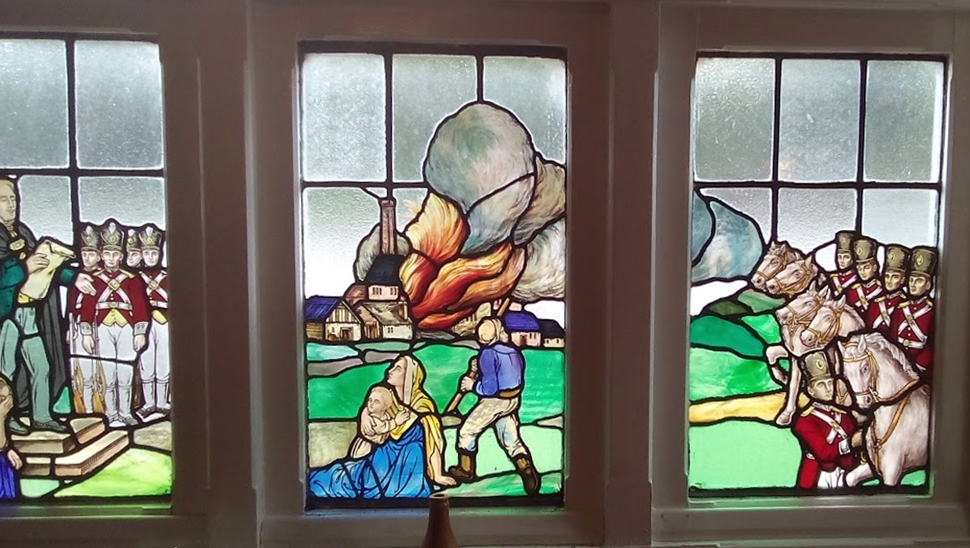Westhoughton Mill on:
[Wikipedia]
[Google]
[Amazon]

 Westhoughton Mill or Rowe and Dunscough's Mill, in Mill Street in
Westhoughton Mill or Rowe and Dunscough's Mill, in Mill Street in
Includes note of the riot
List of accused
{{Coord, 53.548, -2.520, display=title, region:GB_scale:5000 History of social movements Industrial Revolution Textile mills in the Metropolitan Borough of Bolton Demolished buildings and structures in Greater Manchester Westhoughton Buildings and structures demolished in 1912
 Westhoughton Mill or Rowe and Dunscough's Mill, in Mill Street in
Westhoughton Mill or Rowe and Dunscough's Mill, in Mill Street in Westhoughton
Westhoughton ( ) is a town and civil parish in the Metropolitan Borough of Bolton, Greater Manchester, England, southwest of Bolton, east of Wigan and northwest of Manchester.Bolton
Bolton (, locally ) is a large town in Greater Manchester in North West England, formerly a part of Lancashire. A former mill town, Bolton has been a production centre for textiles since Flemish people, Flemish weavers settled in the area i ...
in the historic county of Lancashire
Lancashire ( , ; abbreviated Lancs) is the name of a historic county, ceremonial county, and non-metropolitan county in North West England. The boundaries of these three areas differ significantly.
The non-metropolitan county of Lancashi ...
, was the site of a Luddite
The Luddites were a secret oath-based organisation of English textile workers in the 19th century who formed a radical faction which destroyed textile machinery. The group is believed to have taken its name from Ned Ludd, a legendary weaver s ...
arson attack in 1812. The mill was built in 1804 by Richard Johnson Lockett, a Macclesfield man who lived at Westhoughton Hall. He leased the mill to Thomas Rowe of Manchester in 1808.
During 1811 and 1812 Luddites had been attacking powered mills throughout the English North and Midlands to such an effect that the government in February 1812 passed the Frame Breaking Act making the damaging of powered looms punishable by death. Skilled weavers lost their livelihoods when production moved from a domestic system
The putting-out system is a means of subcontracting work. Historically, it was also known as the workshop system and the domestic system. In putting-out, work is contracted by a central agent to subcontractors who complete the project via remote ...
to new manufactories causing severe hardship and unrest among the workers. Unemployed weavers joined the Luddites believing their only hope was to destroy the machines. The government repressed rebellion by punishing offenders severely. In 1812 Luddite disorder around Manchester reached its peak.
On Friday 28 April, a large crowd of weavers and mechanics gathered in Westhoughton with the intention of destroying the power looms in Rowe and Dunscough's Mill. The Scots Greys
The Royal Scots Greys was a Cavalry regiments of the British Army, cavalry regiment of the British Army from 1707 until 1971, when they amalgamated with the 3rd Carabiniers (Prince of Wales's Dragoon Guards) to form the Royal Scots Dragoon Guard ...
, deployed in Bolton by the government to quell unrest, were sent for but all was quiet when the contingent arrived and they returned to their quarters. Soon after they left, the factory and its contents were set alight and when the military returned the premises were destroyed and the culprits had disappeared. Some rioters gathered in the village in the evening demanding food and drink or money and the military was recalled and the Riot Act
The Riot Act (1 Geo.1 St.2 c.5), sometimes called the Riot Act 1714 or the Riot Act 1715, was an act of the Parliament of Great Britain which authorised local authorities to declare any group of 12 or more people to be unlawfully assembled and o ...
was read. Information about the ringleaders was collected and 24 men were arrested and sent for trial at Lancaster Assizes. Some were discharged but, "for having wilfully and maliciously set on fire and burnt a Weaving Mill, Warehouse and Loom Shop in the possession of Thomas Rowe and Thomas Dunscough at Westhoughton", Job Fletcher, James Smith, Thomas Kerfoot and Abraham Charlson, were sentenced to death and hanged and nine men were transported. After the Luddite act, manufacturers avoided the township until Chadwick's Silk Mill was built in the early 1850s. Westhoughton Hall was attacked at the same time.
According to James Thomas Staton's account of the incident in ''The Brunnin' o' Westhowtun Factory'' (1857), government spies were embedded among the workers and the mill's management had set a trap to ensnare discontent workers by inciting violence among them; some researchers believe this scenario to have been likely.
The mill was rebuilt after the attack and converted to a corn mill, until it was bought in 1840 by Peter Ditchfield, a cotton manufacturer who restored it to a cotton mill. On his death in 1854 the mill, by then employing some 40 people, passed to his son, Peter Ditchfield, jnr. After many years of spinning cotton and making flock, production ceased and the mill stood empty. It was eventually demolished in 1912 and the site is still (2017) a vacant lot.Council information board, Ditchfield Gardens, Westhoughton
See also
*List of mills in Bolton
This list of mills in Bolton lists textile factories which existed at one time or another in the Borough of Bolton, Greater Manchester, England.
From the Industrial Revolution until the 20th century, Bolton was a major centre of textile man ...
References
External links
Includes note of the riot
List of accused
{{Coord, 53.548, -2.520, display=title, region:GB_scale:5000 History of social movements Industrial Revolution Textile mills in the Metropolitan Borough of Bolton Demolished buildings and structures in Greater Manchester Westhoughton Buildings and structures demolished in 1912